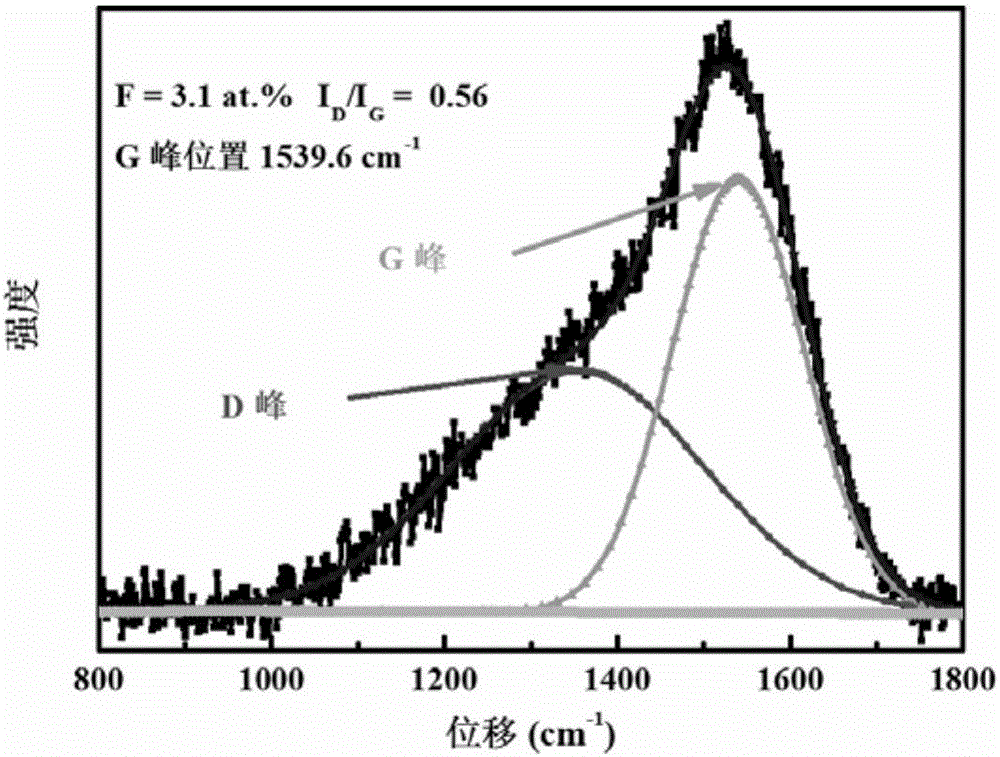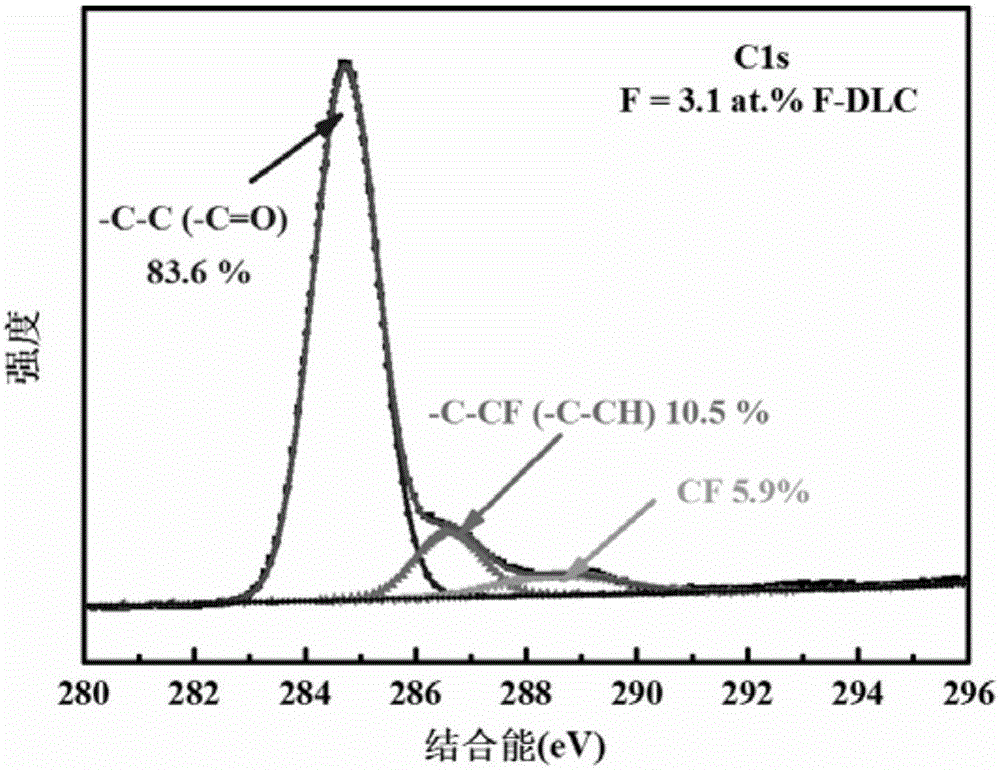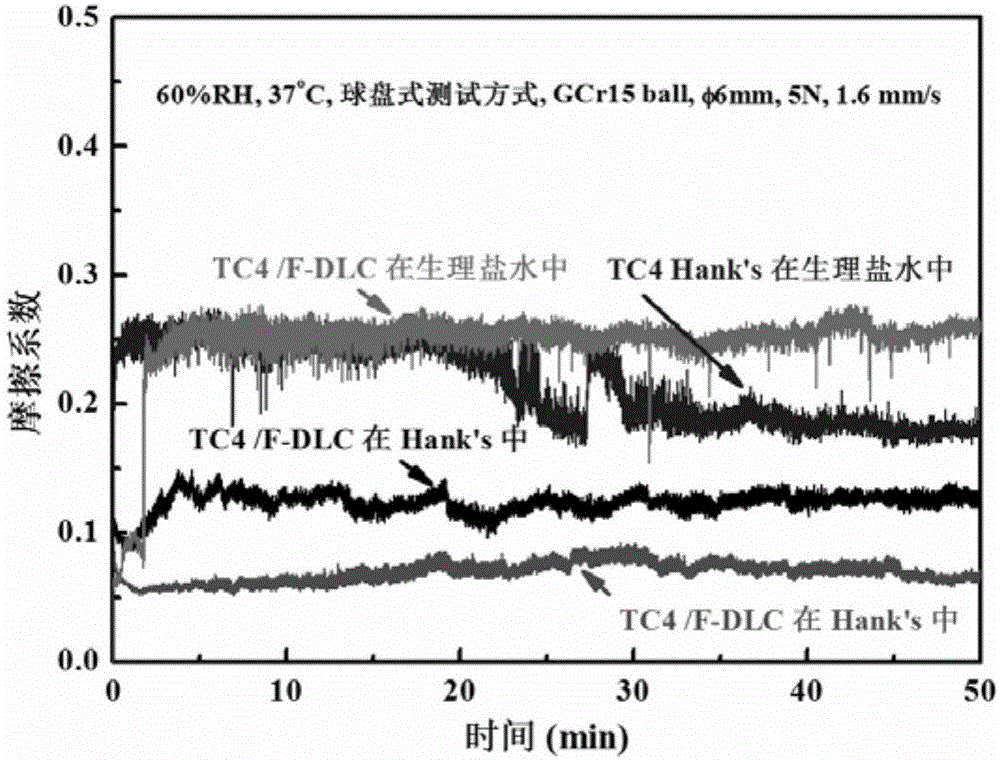Method for preparing antifriction wear-resistant F-DLC film on titanium alloy surface
An anti-friction and anti-wear, F-DLC technology, applied in metal material coating process, gaseous chemical plating, coating and other directions, to achieve the effect of improving stability, solving preparation problems, and improving tribological performance
- Summary
- Abstract
- Description
- Claims
- Application Information
AI Technical Summary
Problems solved by technology
Method used
Image
Examples
Embodiment 1
[0021] To prepare anti-friction and anti-wear F-DLC film on the surface of titanium alloy Ti-6Al-4V substrate, follow the steps below:
[0022] 1) Pretreatment: Polish the surface of Ti-6Al-4V to reduce the surface roughness to less than 10nm, then immerse it in acetone and alcohol solvents and perform ultrasonic cleaning for 15min to remove the dirt on the surface of the alloy. Dry and set aside.
[0023] 2) Sputter cleaning: put the dried Ti-6Al-4V into the middle of two horizontally parallel plates in the reaction chamber of the HP-PECVD deposition system, and vacuumize the reaction chamber. When the pressure in the reaction chamber is lower than 10 -4 Pa, feed argon and keep the pressure of the reaction chamber at 1.3Pa, apply a pulse bias of -8kV on the plate, control the duty cycle to 15%, and the pulse frequency to 1200Hz to sputter the Ti-6Al-4V in the reaction chamber Shot cleaning for 20min.
[0024] 3) Deposition of Si transition layer: After sputtering and cleani...
Embodiment 2
[0028] To prepare anti-friction and anti-wear F-DLC film on the surface of titanium alloy Ti-6Al-4V substrate, follow the steps below:
[0029] 1) Pretreatment: Polish the surface of Ti-6Al-4V to reduce the surface roughness to less than 10nm, and then immerse it in acetone and alcohol solvents for 20 minutes of ultrasonic cleaning to remove the dirt on the alloy surface, and then use nitrogen Blow dry and set aside.
[0030] 2) Sputter cleaning: put the dried Ti-6Al-4V into the middle of two horizontally parallel plates in the reaction chamber of the HP-PECVD deposition system, and vacuumize the reaction chamber. When the pressure in the reaction chamber is lower than 10 -4 Pa, feed argon and keep the pressure of the reaction chamber at 2.0Pa, apply a pulse bias of -13kV on the plate, control the duty cycle to 25%, and the pulse frequency to 1500Hz to sputter the Ti-6Al-4V in the reaction chamber Shot cleaning for 30min.
[0031] 3) Deposition of Si transition layer: After ...
Embodiment 3
[0035] To prepare anti-friction and anti-wear F-DLC film on the surface of titanium alloy Ti-6Al-4V substrate, follow the steps below:
[0036] 1) Pretreatment: Polish the surface of Ti-6Al-4V to reduce the surface roughness to less than 10nm, and then immerse it in acetone and alcohol solvents for 30 minutes of ultrasonic cleaning to remove the dirt on the alloy surface, and then use nitrogen Blow dry and set aside.
[0037] 2) Sputter cleaning: put the dried Ti-6Al-4V into the middle of two horizontally parallel plates in the reaction chamber of the HP-PECVD deposition system, and vacuumize the reaction chamber. When the pressure in the reaction chamber is lower than 10 -4 Pa, feed argon and keep the pressure of the reaction chamber at 2.5Pa, apply a pulse bias of -15kV on the plate, control the duty cycle to 35%, and the pulse frequency to 1500Hz to sputter the Ti-6Al-4V in the reaction chamber Shot cleaning for 28 minutes.
[0038] 3) Deposition of Si transition layer: A...
PUM
| Property | Measurement | Unit |
|---|---|---|
| Wear rate | aaaaa | aaaaa |
| Wear rate | aaaaa | aaaaa |
| Wear rate | aaaaa | aaaaa |
Abstract
Description
Claims
Application Information
 Login to View More
Login to View More - R&D Engineer
- R&D Manager
- IP Professional
- Industry Leading Data Capabilities
- Powerful AI technology
- Patent DNA Extraction
Browse by: Latest US Patents, China's latest patents, Technical Efficacy Thesaurus, Application Domain, Technology Topic, Popular Technical Reports.
© 2024 PatSnap. All rights reserved.Legal|Privacy policy|Modern Slavery Act Transparency Statement|Sitemap|About US| Contact US: help@patsnap.com










